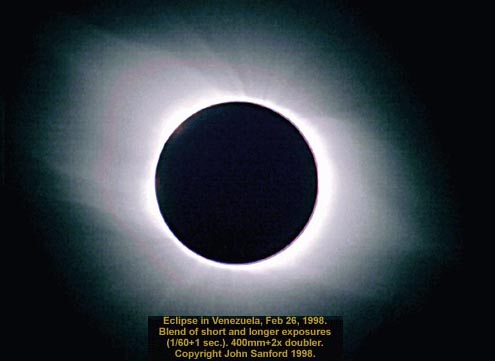
|
Credit & Copyright: J. Sanford
Explanation:
On February 26th, it was dark during the day. This total solar eclipse was the last visible from the Americas
for this millennium.
A total solar eclipse is
exciting partly because it is so short.
Were
Earth's Moon farther away, no total eclipse
would occur at all because the Moon
would appear too small to block out all of the
Sun.
Were the Moon much closer to the Earth,
the eclipse would last much longer.
Oddly, the Sun and Moon have almost
exactly the same angular size.
Even for
well located observers, this
creates at most only a
very few minutes of totality
before the Moon's shadow moves away.
During a
total solar eclipse in 1919,
these few minutes were long enough for scientists to
determine that the Sun's gravity bends light from the stars behind it,
dramatically confirming the accuracy of a
new theory of gravity postulated over 80 years ago.
|
January February March April May June July August September October November December |
| |||||||||||||||||||||||||||||||||||||||||||||||||||||||
NASA Web Site Statements, Warnings, and Disclaimers
NASA Official: Jay Norris. Specific rights apply.
A service of: LHEA at NASA / GSFC
& Michigan Tech. U.
Based on Astronomy Picture
Of the Day
Publications with keywords: Sun - Total eclipse
Publications with words: Sun - Total eclipse
See also:
- APOD: 2025 May 21 Á International Space Station Crosses the Sun
- APOD: 2025 March 16 Á Venus and the Triply Ultraviolet Sun
- APOD: 2024 September 2 Á A Triangular Prominence Hovers Over the Sun
- APOD: 2024 August 18 Á A Solar Prominence Eruption from SDO
- APOD: 2024 August 4 Á Gaia: Here Comes the Sun
- APOD: 2024 July 28 Á Sun Dance
- Prominences and Filaments on the Active Sun
